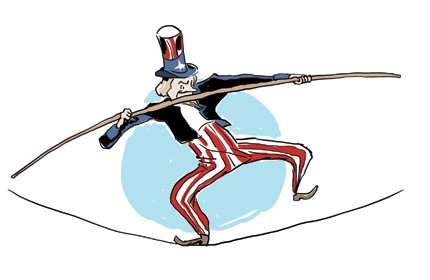US walking a tightrope over South China Sea issues
 0 Comment(s)
0 Comment(s) Print
Print E-mail
Global Times, July 8, 2011
E-mail
Global Times, July 8, 2011

The dispute over territorial waters and islands in the South China Sea between China and its southeastern neighbors has intensified in the past few months. Though the situation has become a little calmer these days, real solutions are yet to be found.
However, things are becoming trickier, as the US and Vietnam announced that they’ll co-launch a search and rescue drill by the end of July. The US, at this critical moment, seems to be intentionally making its position of this matter clearer.
Therefore the next question is will US forces intervene if verbal clashes turns into actual military conflict?
To some extent, it is nothing more than a hypothetical question given the breakout of a military conflict at the South China Sea is almost impossible. But we can infer some possibilities by looking at things from the US perspective.
The relationships between the US and its allies since the end of World War II have been subtle. The allies are always worried about the degree of US reliability when a crisis comes, while the US keeps a calm and watchful eye on global issues, and tries not to get involved in any unnecessary trouble.
It seems that the US is making a commitment to its friends in southeastern Asia with the declaration of the joint drill and the series of actions that followed. However, things might go a bit astray for the US in the coming weeks, given its Asian friends might use such commitment to meet their own interests.
What’s more, the power of the US and that of countries like Vietnam and the Philippines are relatively unequal on this issue. The latter count for little when it comes to the Sino-US relations, since the power of the US is already strong enough to pose a significant challenge to China and the minor powers are of little use in balancing the situation.
In contrast, the US attitude is almost everything if smaller nations like Vietnam want to challenge sovereignty issues in the region. Therefore it is likely that they will try everything they can to take full advantage of the Pentagon’s helping hand in order to advance their own interests, not those of the US.
Under such circumstances, the US policymakers must be well aware that it is of vital importance to stay calm and cautious before making promises if they don’t want to get involved in regional conflicts or even, potentially, armed clashes.
Looking at the US plans at their most basic level, we can see that although it shares some targets with Vietnam and the Philippines, the Pentagon clearly has its own plans in the South China Sea. People won’t be surprised if, in the near future, the US chooses to reverse its previous stand to maximize their own interests.
Vietnam isn’t one of the US allies, nor did the US made any real commitment to South China Sea issues.
However, an ambiguous US attitude in this region is something that those smaller powers badly want. Thus, the US has to make its attitude clear to prevent the country’s strength from being misused. If they don’t, there’ll be trouble ahead.
The US has released a signal that it will step in the South China Sea issues, but it needs to keep the signal appropriate.
On the one hand, the US needs to encourage the Southeast Asian countries which have declared their claims to sovereignty in the South China Sea, but on the other, they have to keep the situation controlled.
The US is walking a careful line to advance its own interests.






Go to Forum >>0 Comment(s)